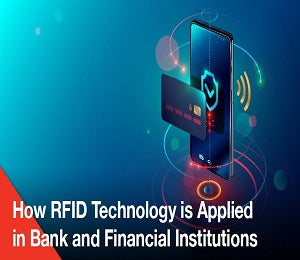
More Security for Banking Sector – RFID Implementations
- Barcode, NFC Business Cards, Pinter, POS System, RFID, smart cities
- 24 Mar, 2022
Banking has been created centuries ago and it is always emerging with advancements. The banking industry has changed in recent years with the help of technology. This has resulted in some benefits like reduced paperwork, long queues, time taken to serve customers, rise of net banking, better customer experience. Banks are using new technologies to offer better services to customers. RFID is one such technology. This technology helps boost the productivity of banks by automating numerous processes.
RFID technology is a powerful option when looking at identity verification, identity theft protection, biometric authentication, and more. RFID tags are scanned by readers when entering the bank and handling of their information is performed in order to identify, track, check, verify, and give more satisfying services to customers like decreases of waiting time, ability to bring security, accuracy, and integrity of the banking systems of the country by accelerating most of the banking works by using electronic infrastructures without disturbance for special customers.
What is RFID Technology?
RFID is a technique of data collection that involves automatically identifying objects through low-power radio waves. information is sent and received with a system consisting of RFID tags, an antenna, an RFID reader, and a transceiver.
What is RFID Banking?
At the point when the customer holding the Radio Frequency Identification (RFID) card finished the transaction and leaves the bank branch, the system will capture his/her exit indicating that transactions have been finished.
Applying RFID Technology in Banking System
By using modern or latest technologies banks are trying to give better services to their customers. An RFID tag is used to identify, track, monitor, verify and give more satisfying services to customers such as decreases in waiting time, capacity to bring security, accuracy, and integrity of the banking systems of the country by accelerating most of the banking works by using electronic infrastructures without disturbance for special customers.
RFID systems can help to have absolute visibility of assets, inventory, clients, and staff to ensure that client banking needs are met.
Advantages of using RFID technology in Banking
RFID technology can help in the following ways:
1. Management of cash and cheque inventory
A steady flow of cash and cheques is required for clients to feel confident in their banking organization. Using RFID tags assets can be tagged and tracked without any problem. Location and stock level of assets can be automatically identified at any time.
2. Management of Banking Equipment.
Tags can be introduced onto every piece of equipment including cash sorter machines, ATMs, PIN Pads, teller help units, and vaults so that maintenance schedules of every critical banking equipment can be tracked using an asset tracking system. This also ensures that equipment is agreed with as per the standards and working as required.
3. Monitoring personnel and integrating with Payroll.
Sign-in and sign-out times of the employees can be tracked and this data can be integrated with existing payroll systems for seamless payroll calculations.
Challenges when using RFID Technology in Banking System
1. Materials like metal and liquid can impact signals.
2. RFID technology can be very expensive than barcode readers.
3. Implementation of RFID can be difficult and time-consuming.










































